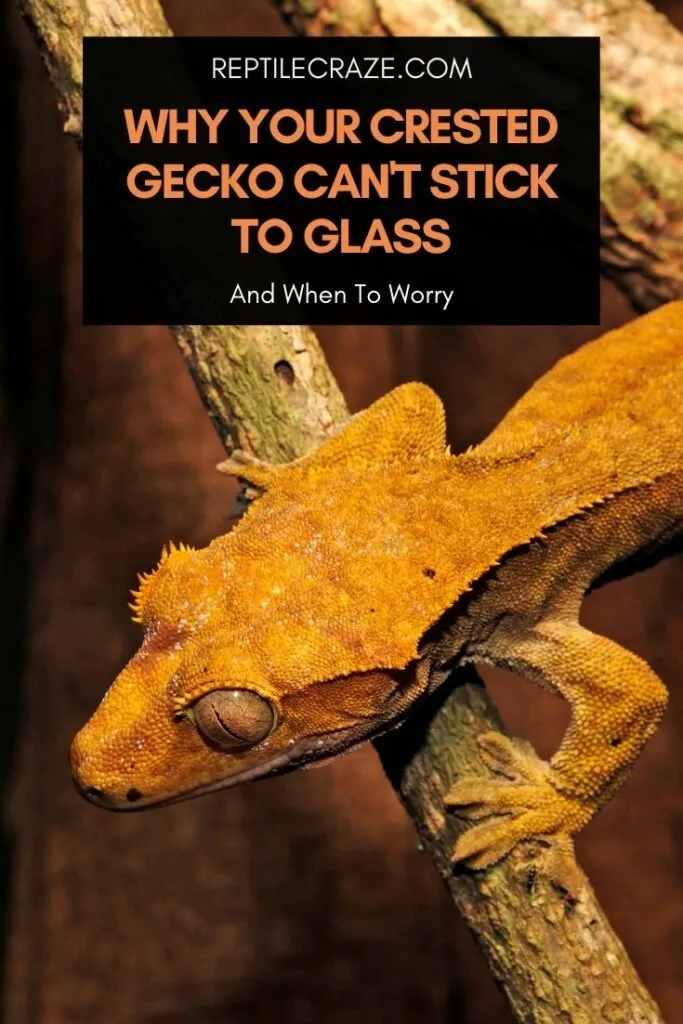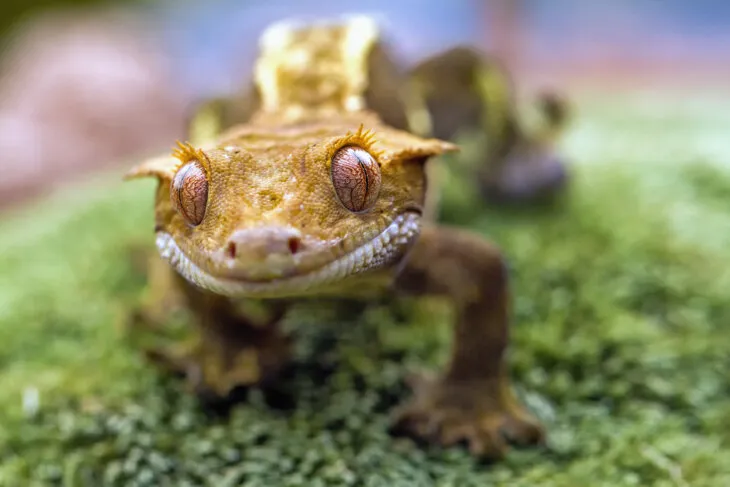
Crested geckos are so fun to look at especially when they stick to the glass of their enclosure. But what does it mean when they keep slipping from the glass? Is your crestie sick? Is something wrong with its enclosure?
Crested geckos cannot stick to the glass when they are shedding or have a stuck shed. Slipping also happens when they are injured or they have blocked setae. It is also possible that the surface is too slippery and the enclosure is too humid.
Before you panic and rush to the vet, just take a breather and read this for a while. We are going to talk about the reasons why your crested gecko cannot stick to glass. Who knows? Maybe its enclosure is just due for a cleaning? Read on!
Reasons Why Your Crested Gecko Can’t Stick To Glass
Crested geckos have this special ability to stick to glass. In fact, some of them, prefer to spend their time and eventually fall asleep while sticking to glass!
This ability is possible due to van der Waals forces which are simply how molecules tend to repel or attract each other which causes sticking or slipping.
Add to that the fact the feet of your crestie are covered with setae (projections that are hair-like) which helps it to stick on smooth surfaces.
Tip: Is your crestie spending every single minute on the glass? Read this article!
1. Your Crested Gecko Is Shedding Or Has A Stuck Shed
When your crested gecko is still shedding, the dry skin is still wrapped on its body thus blocking the setae that help it to stick to the glass. Obviously, if it tries to stick to the glass, the dry skin is the point of contact which leads to slipping.
Why is my crestie not sticking on the glass even if I cannot see any shedding?
Keep in mind that even during the pre-shedding stage, cresties are not so inclined to stick to the glass as they have this instinct that they are about to shed. They do this to prevent slipping which may cause serious injuries.
On the other hand, if you notice that your once “glass-loving” crestie suddenly refuses to do its usual sticking behavior when there are no signs of shedding.
You need to keep a close eye on it as there might be a different underlying issue.
If you notice your crestie attempting to climb the glass after a shed, but it tends to slip, then it is highly likely that it has a stuck shed on one or more of its toes. For this one, you really have to check for stuck sheds immediately.
As your crestie may not even be aware that there is still dry skin on its toes, it will keep trying to stick on the glass.
It may reach a certain sticking point, but since some of its toes are still covered in dry skin, it may slip from a significant height that may cause harm to it.

2. Your Crested Gecko Has A Blocked Setae
We already mentioned how the setae are what helps your crested gecko to stick on surfaces. As the setae are hair-like structures, they are bound to get clogged.
You can think of it as a fluffy carpet. As people keep on walking on it, dropping
It is the same with your crestie’s setae. Dirt,
The tricky part is that this cannot be easily seen. You really have to handle your crestie on a regular basis to see the blocked setae.
What do you do when you notice that there are blocked setae? The first thing that comes to mind is to get water and try to wipe it off, right?
However, as stated in this study, geckos tend to have a self-cleaning mechanism simply by walking around or trying to stick on glass (even if they fail to do so)
According to the study, based on the mechanics of the van der Waals forces, small particles (food particles/ dirt) are more likely to bond with the setae as compared to larger particles (glass surface)
Therefore as the setae continue to bond with smaller particles due to locomotion (walking around the enclosure) the setae now have large particles.
Once the large particle on the setae has contact with the other large particle (wood/glass) the force will repel itself.
This leads to unblocked setae. In the experiments in this study, the geckos tend to self-clean their setae even after just eight steps around the enclosure.
So you need not worry when you notice that there is a blocked seta. Just as long as it is not inflamed nor it has a wound, you can simply let nature run its course.
3. The Surface Is Too Slippery
Working with your crestie’s setae is really trial and error. When it is too humid in the enclosure, it can dehydrate the setae, thus it cannot stick properly to the glass surface.
On the other hand, if there is too much moisture then the surface itself is the problem as the water droplets on the glass as well as the wet setae cannot properly execute the van der Waals force.
The surface and your crestie’s toes will just repel and cause slipping.
The conditions in the enclosure should be balanced to foster an environment where the setae of your cresties are not too wet or dry.
If you really need to mist the enclosure daily based on your temperature settings, it is good to have wooden branches in the enclosure to encourage climbing behavior. You can also clean the water marks to lessen the slippery surfaces on the glass.

4. Your Crested Gecko Is Sick Or Injured
If your crested gecko has a wound on its toes then it will surely keep on slipping from the glass surface no matter how hard it tried to stick to it.
What is worse is that if it still keeps on forcing to stick, the wound may deepen which can permanently cause damage to the setae.
You should always do routine body checks on your cresties just to prevent any major injuries. If it is just a slight wound, you can use an antibiotic ointment which can be prescribed by your vet.
Sickness is another reason why your crestie is not sticking to the glass. If it is malnourished or lacking certain vitamins and minerals in its diet, the setae do not function properly and lose their “stickiness.”
This can also be a sign of Metabolic Bone Disease.
Even if there is still no concrete evidence of the direct correlation between the slipping or non-sticking behavior of crested geckos and MBD, the symptoms that come with MBD prove to dissuade them from sticking to the glass.
At the same time, this may also spell that your crestie is suffering from a neurological issue. They might feel that their balance is off or they experience dizziness. For this, you need to immediately consult your vet.
Floppy Tail Syndrome can also hinder your crested gecko from sticking to the glass. This is when their tail starts to flop as opposed to kink. This usually happens when they are hanging upside down and their tail is just left hanging.
What happens is that the gravity puts too much force on the tail which will then lead it to droop. If you want to learn more about Floppy Tail Syndrome, you can check this article to know if this is something you should be deeply concerned about.
A quick fix to prevent Floppy Tail Syndrome is to discourage the hanging behavior of your cresties. You can do so by putting vertical or horizontal climbing surfaces in the enclosure. Adding hides on the ground can help too.
Final Thoughts
Proper care and enclosure maintenance are key to keeping your crestie’s setae functioning so that they can stick happily on glass. Always do a body check on them just to make sure that they do not have stuck shed or injuries.
In such a case that they do have blocked setae, resist the urge to manually clean it and just give your crestie a chance to do its self-cleaning mechanism.
If the issue still persists, then it is time to check with your vet as your crestie might be suffering from something else that is affecting the stickiness of its setae.
- Enchi Ball Python: A Unique and Stunning Morph of Python regius - March 27, 2025
- Emerald Tree Monitor: The Enigmatic Green Guardian of the Rainforest - March 26, 2025
- The Egyptian Cobra (Naja haje): A Fascinating Serpent - March 25, 2025
